Mark Sisson's Blog, page 335
June 25, 2013
The Primal Blueprint Movie Concept Trailer
After last week’s post announcing my intentions to produce a movie based on The Primal Blueprint, many of you requested more details. I’ll be sharing specifics in upcoming weeks, but this concept trailer should give you a small taste of things to come.
(Note: The film hasn’t been shot yet. The actors and locations in this concept trailer may not be in the final version of the film.)
I look forward to your comments!
Subscribe to the Mark’s Daily Apple Newsletter to Get Alerts on The Primal Blueprint Documentary

June 24, 2013
Dear Mark: Iodized Salt, Weather and Health, and Mercury Fillings
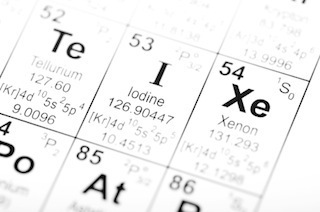 It’s Monday, which means it’s time for another edition of Dear Mark. This week, I’m covering three topics. First up is iodized salt and its place in the Primal eating plan. It’s processed, it’s conventional, and plenty of alternative health purveyors warn against eating it, but how bad is it? Is there actually a place for it in a Primal lifestyle? After that, I discuss the myriad ways the weather can affect our health and physiology, including lowering body temperature, impairing immune function, increasing blood pressure, and triggering joint pain. Finally, I explore whether or not mercury fillings in our teeth are a health hazard, weighing the evidence from both sides of the argument. I also discuss what to do if you want to have them removed.
It’s Monday, which means it’s time for another edition of Dear Mark. This week, I’m covering three topics. First up is iodized salt and its place in the Primal eating plan. It’s processed, it’s conventional, and plenty of alternative health purveyors warn against eating it, but how bad is it? Is there actually a place for it in a Primal lifestyle? After that, I discuss the myriad ways the weather can affect our health and physiology, including lowering body temperature, impairing immune function, increasing blood pressure, and triggering joint pain. Finally, I explore whether or not mercury fillings in our teeth are a health hazard, weighing the evidence from both sides of the argument. I also discuss what to do if you want to have them removed.
Let’s get to it!
Dear Mark,
My understanding of salt use is that sea salt is not iodized. I have read that iodized salt is important to the proper function of the thyroid gland. Supposedly restaurants and other places are steering clear of conventional iodized salt because it is viewed as unhealthy, and can discolor food in cooking.
What are your thoughts on this? Am I wise to still use conventional iodized table salt?
Sincerely,
Glenn
Correct. Sea salt generally is not iodized, unless specified on the package. Sea salt does naturally include some iodine, though usually not enough to qualify as “iodized.” If you don’t have another source of iodine in your diet, and you’re not taking iodine or kelp supplements, I’d say stick with using some iodized salt in your cooking. Maybe half iodized salt and half sea salt.
What sorts of foods contain iodine? Seaweeds of all types contain the most iodine, with the aforementioned kelp (or kombu) being the densest and most easily attainable source. Next time you make broth or soup, add a two inch strip of kelp to the pot toward the end of cooking. After seaweed, iodine content falls off. Other seafoods, like cod or shellfish, are going to be good – but wildly varying – sources of iodine. One filet of cod might have the full RDI while the next fillet has a quarter of it. It’s difficult to know for sure (but isn’t that always the case when dealing with food?). After seafood, yogurt appears to be the best source, followed by eggs, milk, and strawberries. Again, the actual iodine content of these foods depends almost entirely on the iodine content of the soil on which they were cultivated or raised, which also varies.
You should also consider the goitrogen content of your diet. Goitrogens interfere with the function of the thyroid, effectively increasing the amount of iodine required to make sufficient thyroid hormone. Examples of goitrogen-rich foods include cruciferous vegetables like broccoli, cabbage, kale, cauliflower, bok choy, turnips, and Brussels sprouts, as well as soy. Exhaustive online lists of goitrogens include things like strawberries and peaches and spinach, although I’m not sure how detrimental those actually are.
As long as you’re eating enough seafood, eggs, with the occasional foray into the sea vegetable realm without overdoing it on the broccoli, you should be okay without iodized salt. A dash or two of iodized salt, or maybe some kelp granules sprinkled on top your food, can be extra insurance and shouldn’t be harmful. Note, though, that the iodine contents of iodized salts don’t usually match up with the claims on the package. It’s best to just eat a wide variety of foods known to be rich (if unreliable) sources of iodine, so you know you’re covered in the long run.
Hi Mark,
Living in Europe, I often hear Europeans complain about how their ailments often come from the weather. If someone mentions circulation problems, headaches, dizziness, joint pain, heart palpitations, low or high blood pressure, or stomach aches, more often than not, someone will chime in: “It must be the weather!” Even doctors here will say this. They attribute it to temperature differentiation and transitions from cold to warm and vice versa. Some also think you’ll get sick if you walk barefoot on a cold floor. And as soon as one starts to get a cold or sore throat, they wrap a scarf around their neck and wear it indoors as well as outdoors.
So my question is, does weather really have an effect on our health as they make it out to have? Thanks!
Brian
Well, weather certainly has a measurable effect on our physiology. Whether that translates to an effect on our “health,” I’m not so sure. Let’s go through it a bit, though. Disregarding the obvious ones like heat stroke, dehydration, frostbite, etc, what physiological markers can weather affect?
Body temperature: Being warm-blooded animals, we generally maintain a consistent body temperature regardless of the outside temperature. That doesn’t come freely, though. We have to actively maintain body temperature through subconscious physiological adjustments. When it’s hot, we sweat, and the evaporating water cools us. Our body hairs also lie flat in hot weather, preventing hot air from building up and getting trapped between the hairs. Our arteries also dilate, allowing increased blood flow and improved heat loss. When it’s cold, the opposite happens. We stop sweating, our hairs stand up (goosebumps), and our arteries constrict. Blood flow is directed toward the warmer (and vital) interior and away from the “non-essential” extremities to further reduce cooling. Taken to an extreme, this can manifest as frostbite, or tissue death.
Blood pressure: Recall that in order to restrict blood flow and maintain body temperature in cold weather, our arteries constrict. This vasoconstriction triggers an increase in blood pressure, which, particularly in susceptible or already-hypertensive people, can precipitate dangerous conditions like stroke or heart attack. In fact, head and neck cooling directly increases blood pressure, heart attack and stroke deaths peak in winter time, and a low body temperature is associated with an elevated risk of stroke. If you’re perpetually cold, or suffer from a low body temperature, it’s possible that this could trigger a pathologically hypertensive state.
Immunity: Can you really catch a cold from being out in the cold without a jacket? That’s what mothers have been claiming for eons, but how true is it? Well, a low body temperature is associated with lowered immune function. There are several lines of evidence showing this:
When hibernating, bears have a low body temperature and lower levels of circulating immune cells.
In colon cancer patients, pre-op induced hyperthermia is an effective way to prepare their immune systems to withstand the shock of surgery.
Disgust – yes, getting grossed out by something – is an effective upregulator of immunity. This immune boost is regulated by an increase in body temperature. So, basically, you see something yucky, your body figures that whatever it is could make you sick, and your body temperature rises to improve your immune system.
Exercising impairs the immune system. Exercising in cold weather impairs the immune system even further.
A drop in body temperature has been shown to increase a person’s susceptibility to catching a cold.
The most basic immune response our bodies have at their disposals – the fever – is characterized by a rapid elevation in body temperature.
So, yes, there is something to all those old wives’ tales. If walking barefoot on a cold floor lowers your core body temperature enough to impair your immune function, it may very well leave you open to infection. However, cold weather in and of itself is not the cause. Lowered body temperature is the cause. Keep your body temperature up and you’ll be more resistant.
Joint pain: That old guy with the limp who claims he can predict the weather might be telling the truth; human joints contain sensory nerves called baro-receptors, which are highly attuned to fluctuations in atmospheric pressure. They’re particularly sensitive to the drops in pressure that occur when the weather turns from dry to wet, like when a rainstorm is about to hit. A recent review of rheumatoid arthritis studies concluded that “pain in some individuals is more affected by the weather than others,” suggesting that while the weather/joint pain connection isn’t true in anyone, it does exist in some people.
However, healthy, intact, stable joints shouldn’t hurt because of incoming wet weather. Weather won’t cause pain in something that isn’t already a bit impaired.
I hope that answered your question.
Do you recommend having amalgam mercury-containing fillings taken out and replaced with some other filling substance? Can mercury in your teeth cause havoc in your body after years of being there? Can mercury in your teeth cause hormone imbalance, thyroid problems, hair loss, brain fog, etc. and other symptoms of hormone imbalance?
Sandra
That’s a tough one. The evidence is pretty clear, though, that mercury-containing fillings do release mercury into your body, and they may increase the levels of mercury in your body, despite what mainstream outlets will tell you. What’s not totally clear is whether the dose provided by the typical mercury filling is enough to negatively impact health. Some reviews have found that only “hypersensitive” people are vulnerable to mercury fillings (even though they do give off mercury). Meanwhile, the presence of mercury amalgams has been fingered as a risk factor for autoimmune disease.
I don’t doubt that it’s hard to find evidence of health problems just from looking at people with fillings. It seems like looking at what happens to people who had fillings removed would be more helpful. Seth Roberts, in whose dedication to the science of self-experimentation I place a lot of trust, found that his brain function (as measured by timing himself doing basic arithmetic problems) markedly improved after removing two mercury fillings. There’s also evidence that mercury filling removal can improve thyroid function in patients with autoimmune thyroiditis and health in patients with autoimmune diseases in general. Evidence of benefits upon removal appears to be evidence of harm, no?
Unfortunately, the very act of eating, of masticating, of chewing, of grinding up food against your mercury filling and then ingesting it increases the amount of mercury released and absorbed, which is why gum addicts with mercury fillings absorb way more mercury than more moderate chewers with fillings (or non-chewers with mercury fillings, for that matter). Man can’t live on smoothies alone, however. He must chew his food, and this makes mercury avoidance tough when it’s sitting in your mouth. Removal seems prudent.
I’ve heard that unless specific precautions are taken, the very act of removal can release a ton of mercury into your body, more than would happen over the lifetime of just keeping the fillings. Depending on how the filling is drilled out, the patient can inhale the mercury fumes or swallow the cloud of mercury particulates. As I mentioned, however, Seth had great results from removal. If you decide to get them removed, heed the advice given by the International Academy of Oral Medicine and Toxicology with regards to safe removal of fillings. Find a dentist who understands and adheres to these guidelines before you even consider going forward with the procedure.
That’s it for this week, guys. As always, keep sending in any questions you have and I’ll do my best to get to them. Thanks for reading!
Limited Time Offer: Get a FREE Copy of The Primal Blueprint 90-Day Journal When You Order the Primal Essentials Kit on Autoship>>

June 23, 2013
Weekend Link Love
 Research of the Week
Research of the WeekPeople who live with the most green space nearby (trees, grass, parks, etc) have the lowest levels of salivary cortisol, a marker of stress.
Chocolate with high cacao-content appears to be an effective sunblock when eaten.
New evidence suggests that part of what made human beings possible (and helped our ancestors diverge from the chimp line of ancestry) was the evolution of our transcription factor binding sites – the places where genes are turned on and off. In other words, humans are extremely flexible and adaptable because our genes are extremely flexible and adaptable.
Interesting Blog Posts
How mood – and maybe depression – is a function of how connected we are (or aren’t) to other people. I certainly hope so, because you can’t put a patent on relationships the way you can with Prozac.
Our emotional state can affect our taste for – and awareness of – fat in food.
Media, Schmedia
How junk food can end obesity. Or, another apologist for the processed food industry rears his head.
“The attitude out there is that grass-fed is for the crazies.” Luckily, an increasing number of ranchers, including a favorite of mine – Prescott Frost – are working to change that “cultural kind of fear-mongering,” and it appears to be working.
Everything Else
From the Caltons, 8 foods we eat in the U.S. that are banned in other countries. Jealous, other countries?
Interested in a free poultry purchasing guide, with detailed breakdowns of all the poultry producers and products you’ll find in groceries and markets? Consider supporting the BuyingPoultry.com Kickstarter.
I assure you, I had nothing to do with this.
Recipe Corner
No longer does your baby bok choy have to come dripping and sweating from the steam bath. Now, you can simply grill it.
If you make that bok choy recipe, maybe serve it alongside this ginger chicken with broccoli recipe. It’s like the stuff from PF Chang’s, only without the soybean oil swimming pool.
Time Capsule
One year ago (Jun 23 – Jun 29)
Why Did My Cholesterol Go Up After Going Primal? – Some people report elevated cholesterol readings upon going Primal. Why might this be?
Dear Mark: Personalizing the Primal Blueprint – Several dozen ways you can personalize your Primal Blueprint experience.
Comment of the Week
The only thing I’d add to your ideal bath is to have Paul Togioka’s Hawaiian slack string guitar album “Ki ho’alu Inn” playing in the background. It’s such peaceful, happy music, it always takes me away.
-Indeed, Janice James. How could I have forgotten music?
Limited Time Offer: Get a FREE Copy of The Primal Blueprint 90-Day Journal When You Order the Primal Essentials Kit on Autoship>>

June 22, 2013
Frozen Coconut Macadamia Bars
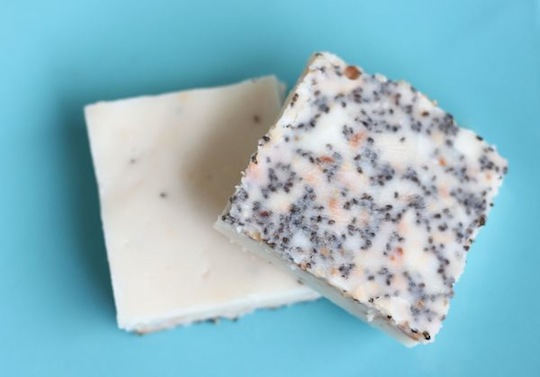 Is it a Primal Energy Bar or the perfect Primal dessert? Call them what you will, these delicious little morsels deliver a healthy dose of fat and protein and satisfy an urge for something sweet. Frozen Coconut Macadamia Bars are incredibly easy to make and have an deliciously decadent flavor and texture.
Is it a Primal Energy Bar or the perfect Primal dessert? Call them what you will, these delicious little morsels deliver a healthy dose of fat and protein and satisfy an urge for something sweet. Frozen Coconut Macadamia Bars are incredibly easy to make and have an deliciously decadent flavor and texture.
Macadamia nuts and coconut oil add a naturally sweet taste. Coconut flakes and chia seeds add a crunchiness that contrasts perfectly with the otherwise smooth and creamy texture of the bars. That’s it for ingredients. Just pop the bars in the freezer and 30 minutes later they’re done. Keeping the bars frozen is essential; if left out too long they’ll start to melt. The cold texture is partly what makes them so delicious, almost like a Primal ice cream bar.
Low-calorie they are not, so don’t plan on eating an entire pan of Frozen Coconut Macadamia Bars in one sitting. The good news is that the bars are so rich and satisfying that you’re not likely to be tempted to overindulge. A small bar is all you need for that special occasion.
Servings: 12 to 14 small bars
Time in the Kitchen: 15 minutes, plus 30 minutes to freeze bars
Ingredients:
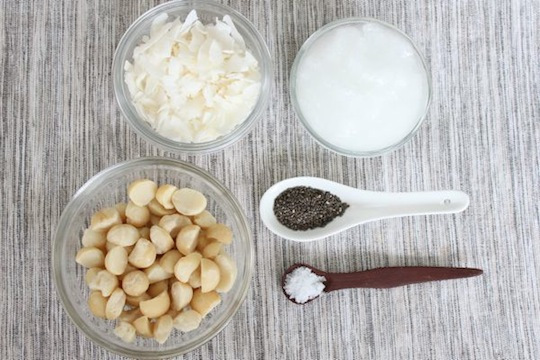
1 cup unsweetened flaked coconut (60 g)
1 1/2 cups raw, unsalted macadamia nuts (150 to 160 g)
3/4 cup melted coconut oil (180 ml)
1 tablespoon chia seeds (15 ml)
Pinch of sea salt
Instructions:
Preheat oven to 350 ºF.
Put the coconut flakes in a pan and toast in the oven until lightly browned, about five minutes.
Line an 8×8 pan with parchment paper.
Process the macadamia nuts and coconut oil in a food processor until very smooth. Add the coconut flakes and chia seeds and pulse a few times.
Pour the batter into the 8×8 pan. Sprinkle a pinch of sea salt on top.
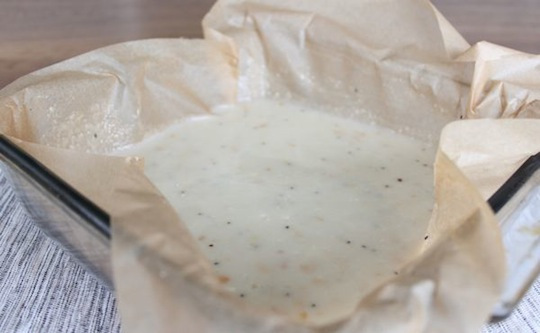
Freeze until solid, about 30 minutes.
Cut into small bars. Store in the freezer.
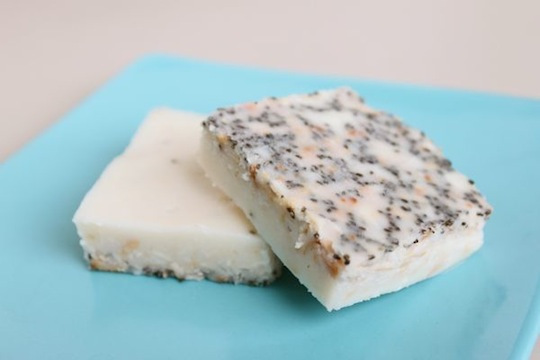
Not Sure What to Eat? Get the Primal Blueprint Meal Plan for Shopping Lists and Recipes Delivered Directly to Your Inbox Each Week

June 21, 2013
Freshman 15? How about Freshman 40!
It’s Friday, everyone! And that means another Primal Blueprint Real Life Story from a Mark’s Daily Apple reader. If you have your own success story and would like to share it with me and the Mark’s Daily Apple community please contact me here. I’ll continue to publish these each Friday as long as they keep coming in. Thank you for reading!
 Dear Mark,
Dear Mark,
Last summer, I moved to Nashville, TN to start college. During my first semester of my freshman year, I didn’t really care much about my nutrition and ate lots of different foods. My friends and I would eat biscuits and gravy, cereal, burgers and fries, Krispy Kreme and of course, delicious Starbucks drinks. I had heard of the “freshman 15″ which was a rumor that all freshman gain 15 pounds in their first year but I didn’t think much about it. Over Christmas break, I spent time with my family in Canada and we ate even MORE food. Plenty of sweets and I didn’t even care about my portions or what I was eating. It was tasty food, right? No harm. I didn’t realize how much I had changed until the last day when I was heading back to college. My dad weighed my suitcase that was being checked at the airport and I decided to weigh myself. I was absolutely surprised by the number: 178. Chills went down my spine. How could I be 5′ 7″ and weigh that much?? My dad was on an “Eat To Live” diet and I actually weighed 3 lbs. more than him. I never told him because I was so embarrassed. So, I decided, that day, on my way to the airport that I would get my act together.
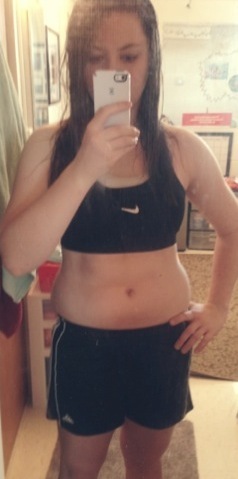 I completely quit eating the cookies and cakes offered at my cafeteria and I ate many salads. My issue was finding what was the RIGHT thing to eat. I knew sugar was bad, but what about oatmeal? What about beans? I started by trying a vegetarian diet and I got a trainer on campus to help me lose weight. He had me take a photo and told me to put it somewhere until summer to see end results.
I completely quit eating the cookies and cakes offered at my cafeteria and I ate many salads. My issue was finding what was the RIGHT thing to eat. I knew sugar was bad, but what about oatmeal? What about beans? I started by trying a vegetarian diet and I got a trainer on campus to help me lose weight. He had me take a photo and told me to put it somewhere until summer to see end results.
We started working out Monday through Friday from 6 am-7 am. It was brutal and painful. I had classes right after that all day plus evening music gigs I was a part of around town. Needless to say, life was getting stressful. He had me eating 5 to 6 times a day. A lot of in between snacks was fruit. I constantly found myself hungry and craving more food after every meal. I tried going vegan during this time and became very malnourished especially since our cafeteria did not have many healthy options for meals. I ate lots of oatmeal and egg white omelets in the mornings and light salads with some cucumbers and tomatoes every night. It was like I was eating air. I never felt satisfied but I truly thought I was improving and losing weight. A couple months later (March), it was time to go home for spring break. I didn’t look much different but I believed I was on the right path. I spoke to my step-brother and sister in law (who have been Primal for a couple years and are huge role models in my life) and they felt I was putting in too much effort to lose this weight. They told me I didn’t need to force myself awake to work out or get in 1 of my 6 meals everyday and I could lose my weight simply by cutting out the carbs in my diet. They were very convincing so I decided I would try the Primal Blueprint diet.
When I got back to school, I once again changed my nutrition and workouts. I quit my trainer, started eating (and I mean EATING) more eggs, rotisserie chicken, and all the veggies my stomach could handle. I even got creative with the omelet lady and had her make me pancakes out of almond meal and coconut meal that I brought to the cafeteria some mornings. I always kept a jar of coconut oil in my backpack for the cooks to make some of my food in the cafeteria. I also would make my own chocolate ice cream in my dorm room by blending a frozen banana with ice, coconut milk, and dark cocoa. This helped me keep my sanity while my friends ate their sweets! I noticed that the protein was helping hold me over and my weight seemed to shed off much easier.
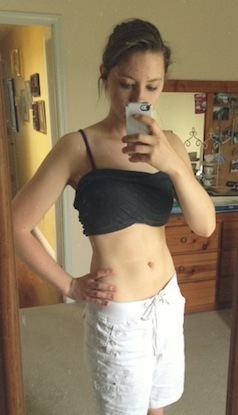
I decided towards the end of the semester that I wanted to focus more on doing exercises I enjoy rather than force myself into a gym everyday (although I still like going to the gym sometimes). I would jog around the school some days, play sand volleyball with friends, do yoga, play tennis or simply go for a walk. Becoming Primal was such an easy change for me. My friends were also interested in how I was eating healthy while going to our crappy cafeteria and would sometimes ask questions in what my secret was as they saw my overall physique change. Most of my friends assumed I was killing it in the gym and was surprised to hear that wasn’t the case.
After about 2 months of being on my Primal Blueprint diet in college, I survived and it was time to go HOME! I was so excited to show my family how much I changed and boy had I ever! I weighed myself at 138 pounds (40 lbs lighter!!) and never felt better!
I haven’t felt so good about how I look in a very long time. What surprises me is how much LESS I have to work out to lose the weight! No more dreaded hours in the gym. I enjoy doing some CrossFit WODs at my home and taking long walks. My exercises and eating habits completely depend on how I feel each day which seems so much more normal to me than pre-planning meals and workouts like I used to. Since I am so new to this diet, I am getting mentored by my two lovely Primal siblings who will help me maintain my weight.
I’m very thankful for your website which helped me in so many ways this semester and thanks to the Primal Blueprint diet, I have conquered that nasty “freshman 15″ rumor and proved that it is possible to be Primal even as a college student!

Grok on!
Amy B.
Get the 7-Day Course on the Primal Blueprint Fundamentals for Lifelong Health Delivered to Your Inbox for FREE

June 20, 2013
8 Primal Mantras for Beginners
 Becoming healthy is as much a mental process as it is a physical experience. Most of us would admit we find ourselves overhauling much more than simply our dinner plates or daily exercise. Oftentimes, we’re upending years – or decades – of unhealthy inertia as well as eating, destructive self-talk as well as inactivity. I hear from a lot of beginners who say they look to certain posts or even paragraphs when the going gets tough. Something they read here sticks with them, and it touches off something in their motivation. On a good day, it helps them go the extra mile. On a crappy day, it offers them a kind of reset button. All of us, I think, have those phrases, sayings – mantras – that bolster us in some personal way. Whether we’re standing at the beginning of a new healthy lifestyle change or rounding mile twenty in a marathon, tapping into the power of our mantra mentality can transform the energy we bring to a given moment and our journey as a whole.
Becoming healthy is as much a mental process as it is a physical experience. Most of us would admit we find ourselves overhauling much more than simply our dinner plates or daily exercise. Oftentimes, we’re upending years – or decades – of unhealthy inertia as well as eating, destructive self-talk as well as inactivity. I hear from a lot of beginners who say they look to certain posts or even paragraphs when the going gets tough. Something they read here sticks with them, and it touches off something in their motivation. On a good day, it helps them go the extra mile. On a crappy day, it offers them a kind of reset button. All of us, I think, have those phrases, sayings – mantras – that bolster us in some personal way. Whether we’re standing at the beginning of a new healthy lifestyle change or rounding mile twenty in a marathon, tapping into the power of our mantra mentality can transform the energy we bring to a given moment and our journey as a whole.
Take it one Primal choice at a time.
It might feel foreign at first. You might worry about venturing too far from the realm of conventional wisdom. You might just feel overwhelmed by the change – any change. The anticipation of all or nothing dissuades too many people who want to make a positive shift in their lives. Don’t worry about whether you will show up for it tomorrow. Just show up for it today. Do whatever mental gymnastics you need to do to make a good choice right now. Then, do the same later when it’s time to move onto the next decision. Eventually, you won’t need to play the game.
I deserve this.
Mental gymnastics aside, know in your core that you were meant for this. You were meant to have all the vitality you will have. You were meant to be strong, agile, lean, energetic, balanced, happy. And let’s just cover the obvious. Do you deserve a cupcake because you had a stressful day? No. You deserve a full and healthy life to help you put that stressful day in physical and emotional perspective.
Pay myself first.
Pay yourself first and the rest will follow. This is akin to the Primal Connection Habit of Highly Effective Cavemen/women, “Be Selfish.” As I suggested there, this isn’t an argument for shallow self-absorption. It’s not a justification for wild egotism. I’m talking here about the necessary commitment to self-care that you deserve but too many of us lose sight of. Wanting time for essential exercise – not selfish. Wanting to shift budgetary allocations to allow for a step up in food quality wherever possible – not selfish. Wanting reasonable quiet in the house to allow for a sane bedtime – not selfish. Wanting a chance to maintain and enjoy the support of a social circle – not selfish. Giving ourselves the things we need to build a healthy life serves our well-being and – by extension – others’ we love or work with in some way. Depriving ourselves out of a sense of obligation sets us up for failure and resentment. Meeting our essential Primal needs will let us operate from our full potential. Win-win for everybody, but it has to start with a commitment to yourself. When we finally “get it” and decide to live life on full rather than empty, we become amazed at what is possible.
It’s a journey not a race.
Beginning a Primal journey will undoubtedly show you big results early on. That said, it’s important to bring reasonable expectations to the rhythm of progress. Don’t shortchange your vision in terms of ultimate result, but be patient with the process itself. If you’re trying to lose 100 pounds or put on 20 pounds of muscle, it’s not going to happen overnight. Dialing back diabetes takes more than a few weeks. Overcoming hormonal issues or recovering from gastrointestinal disorders are long term propositions. With commitment, there’s almost no limit to what you can do, but do yourself a favor by settling into the journey. I suggest that people at any point in Primal living but especially during the early months develop a wider awareness. Hone the subtlety and patience to discern deeper changes in how you feel and what progress looks like each day.
Celebrate something every day.
On that note… As I mentioned a few months ago, giving small wins their due can have a major impact on one’s whole enterprise. Don’t get so caught up in the end goal that you forget that progress is made one step, one day at a time. Celebrations don’t have to be nightly news material. Most days it will be the little stuff, which is coincidentally the stuff that makes the big deals possible. Maybe you got a good night’s sleep or resisted the junk food in the break room at work. Maybe you tried a new Primal dish or didn’t experience the midafternoon crash and burn after that amazing new Primal lunch. Perhaps you ran longer or lifted more than you ever have. Maybe you made your first attempt at interval training. Maybe you got outside for lunch or away for a weekend on a much needed personal retreat. Perhaps you talked with your spouse or took the dog for a walk instead of watching T.V. Maybe you stayed up too late and finally, really realized you don’t want to do that anymore. Celebrate the successes, the choices, the lessons of each day. There is no such thing as a day with nothing to celebrate.
Embrace the pleasure principle.
A lot of people come to the Primal Blueprint having felt lousy for many years. It might be because of excess weight, medical issues, or general lack of energy. The point is, many of these folks have forgotten how to feel – let alone hone – basic physical pleasure in their lives. When you live with constant pain or fatigue, it can be hard to see clear across to the other side of the spectrum. Take the time and effort to feel good again. Living Primally will do its work in easing the physiological issues, but inject pleasure into your lifestyle (e.g. get a massage, take a good bath, make really good food, enjoy the sensory elements of everyday life). The idea here is to reorient your experience of your body. Find ways to feel good, and you’ll be motivated to live a life that supports pleasure as a dimension of full well-being.
Don’t let the perfect be the enemy of the good.
I say this all the time, and people tell me it’s one of the concepts that gives them perspective along the way. It’s why I believe in the 80/20 Principle. Living Primally is a life – not a formula. Reject the all-or-nothing mentality. Check your perfectionism at the door and relax. Follow the basics to the best of your ability. Bring your good intentions, a little forethought, and some Grok-style resourcefulness to each day. The journey will evolve over time – as will your Primal cooking repertoire, fitness enthusiasm, and Primal vision for life as a whole.
It’s a lifestyle, not a diet.
In keeping with the above, the Primal Blueprint isn’t simply about what to eat or even how to exercise. It can certainly be applied in these circumscribed bounds, but it’s much more than a short-term fix or a long-term meal plan. The real power of it unfolds more expansively, more personally than that. At its best, the PB becomes a way of viewing the potential and scope of health itself.
Thanks for reading, everyone. What are/have been your go-to mantras? Do you identify with any of the above? How and when do you use them in your Primal life? Have a great end to the week.
Get the 7-Day Course on the Primal Blueprint Fundamentals for Lifelong Health Delivered to Your Inbox for FREE

June 19, 2013
First Look: The Primal Blueprint Documentary
With your help, it could become a reality.
The Indiegogo crowdfunding campaign begins in July 2013.
Stay tuned for developments, trailers and more!
Subscribe to the Mark’s Daily Apple Newsletter to Get Alerts on The Primal Blueprint Documentary

June 18, 2013
How to Take a Better Bath
 The act of taking a bath doesn’t necessarily need gussying up. Simply submerging your body in hot water and rubbing yourself with an emulsifying agent will get you clean enough, with the potentially added benefits of wicking away stress and inducing relaxation. But in this age of high-tech shower heads and limited free time, the utilitarian shower has won out over the bath. You don’t have to wait for the tub to fill, you’re not stewing in your own juices, and the added pressure of the shower helps blast dirt, skin cells, and natural oils from your body. The bath just can’t compete with the shower for its cleaning prowess.
The act of taking a bath doesn’t necessarily need gussying up. Simply submerging your body in hot water and rubbing yourself with an emulsifying agent will get you clean enough, with the potentially added benefits of wicking away stress and inducing relaxation. But in this age of high-tech shower heads and limited free time, the utilitarian shower has won out over the bath. You don’t have to wait for the tub to fill, you’re not stewing in your own juices, and the added pressure of the shower helps blast dirt, skin cells, and natural oils from your body. The bath just can’t compete with the shower for its cleaning prowess.
Who takes baths for cleanliness, though? Let’s face it: a bath is about relaxation. It’s about treating yourself, soothing sore muscles, catching up on a good book, and letting go and forgetting about the madness of what just transpired that day. It’s a mini-vacation. And there may even be some health benefits. Like anything with those qualities, it can probably be improved upon, or “hacked,” if you will. If we care about our health – and how much we enjoy the little things that make life worth living – we owe it to ourselves to take a better bath.
Here’s how to do it:
Add epsom salts or magnesium chloride flakes.
If you could make just one change to your bath routine, it should be to add a source of magnesium to your water. Epsom salts, available in every drug store I’ve ever entered, contain magnesium sulfate. Magnesium chloride flakes, available online and in aquarium supply shops, contain magnesium chloride (obviously). Both are helpful additions to your bathwater, and both can increase serum levels of magnesium when applied to the skin.
In one study (PDF), subjects took daily epsom salt baths for a week straight. Each bath was 12 minutes in duration and varied between 50 and 55 ºC. When the week was up, magnesium levels were significantly elevated in the majority of the subjects. In a few people whose pre-treatment levels were already replete, urinary excretion of magnesium increased, suggesting that excess magnesium does get absorbed but not retained. As an added bonus, epsom salt baths also provide ample amounts of bioavailable sulfate, a hugely important mineral in mammalian physiology.
Topical magnesium chloride has also been shown to increase serum levels of magnesium in human subjects (PDF). Every day for 12 weeks, subjects were given 20 sprays of magnesium chloride to the body and took a 20-minute foot bath in a magnesium chloride solution. After 12 weeks, hair mineral analysis showed that participants increased magnesium levels by an average of nearly 60%. They also improved their calcium:magnesium ratios.
Because they’re so heavy, epsom salts just aren’t very economical to purchase online. The shipping precludes it, unless you buy 25-50 pounds a time. Even then, most drug stores offer epsom salts for around a dollar a pound.
Magnesium chloride is more expensive than epsom salts, but also more effective. It’s also the form of magnesium found in seawater, the original (and world’s largest) bathtub. A nice compromise would be to add a cup or three of epsom salts to your bath, then spritz yourself with some magnesium chloride oil, which you can either buy or make yourself. I’ve found that this combination reliably helps me sleep and gives me vivid, enjoyable, memorable dreams.
Add other salts.
It’s tough to get real information on actual bath salts, because googling “bath salts” returns page after page of information on the notorious designer drugs masquerading as bath salts. As far as I can tell, the only significant body of bath salt research in existence deals with Dead Sea salts. It seems that bathing in Dead Sea salts, also called Tomesa therapy, improved the skin health of patients with psoriasis and normalized the levels of Langerhans cells (a kind of macrophage that helps with tissue healing and can get out of control in certain skin diseases). A bath in regular sodium chloride (salt) had no effect. Another study found that magnesium-rich Dead Sea water improved skin hydration, skin barrier function, and reduced skin inflammation in atopic dry skin.
Bathing in the Dead Sea had a positive effect on patients with both rheumatoid arthritis and osteoarthritis by reducing inflammation. In osteoarthritis of the knee, a two week Dead Sea bath treatment resulted in a 3-month abatement of symptoms. A recent literature review concluded that the Dead Sea makes for an effective resort for patients with various types of joint ailments.
Also interesting is the effect on type 2 diabetics. A single immersion in the waters of the Dead Sea lowered blood glucose levels in type 2 diabetics.
I suspect using other sources of bath salts, like Salt Lake bath salts, will offer similar benefits.
Add carbonation.
A lukewarm (36 ºC) bath full of carbonated water boosted the performance of competitive swimmers when taken before a workout. Subsequent lactic acid threshold was higher, heart rate took longer to become elevated, and muscles were more efficient after a carbonated bath. Swimmers who took a regular bath at the same temperature enjoyed none of the same benefits.
I don’t mean upending cases of San Pellegrino into your bathtub (although that would be extremely effective, albeit prohibitively expensive). Bath bombs should do the trick. Alternatively, you could use the same formula used by American practitioners who were trying to replicate the famous carbonated baths of Europe:
Sodium carbonate: 1½ lbs
Sodium bicarbonate (baking soda): ½ lb
Calcium chloride: 3 lbs
Sodium chloride: 2 lbs
Sodium bisulphate: 1 lbs
Mixing vinegar and baking soda should also work, as would dumping in some dry ice.
Add essential oils.
First and foremost, essential oils added to a bath improve the sensorial experience. You pick an oil whose scent you enjoy, sprinkle a few drops where the water hits the bottom of the tub to disperse it, and revel in the herbaceous cloud enveloping you. That alone is worth it.
Second, inhaled fumes of essential oils may exert beneficial physiological effects on us:
Rose essential oil inhalation reduces cortisol.
“Green odor” inhalation, the fumes given off by plantlife, reduces stress in rats. This could partially explain the stress-reducing effects of forest bathing in humans.
Sweet orange oil fumes reduce anxiety in humans.
Inhalation of citrus bergamia (Bergamot orange) essential oil relaxes human subjects by shifting them toward parasympathetic nervous system activity.
Smelling lavender and rosemary lowers cortisol in human subjects.
Add a bit of extra virgin olive oil.
Every so often, I’ll make like the Romans and add a tablespoon or so of really good extra virgin olive oil to the running bath water. When you get out, your skin is covered in a thin layer of EVOO, and toweling off serves to rub it in. This will keep your skin well-moisturized.
Just make sure to wash the bottom of the tub before anyone else uses it. It gets very slick and dangerous.
Use bathing as a warmup before workouts, long walks, or any other physical activity.
Bathing is a good way to passively warmup. It, quite literally, warms up your muscles and prepares your body for movement. Stretching, dynamic warmups, and working out are all more effective and safer after warming up your muscles, whether through movement or through sitting in a hot bath. Hot baths are especially helpful in cold weather.
A hot bath before a workout may even increase fat loss. One recent study found that taking hot baths increased the release of free fatty acids from fat stores. Exercising immediately after a hot bath, then, will burn those free fatty acids and prevent them from being deposited back into adipose tissue.
You don’t have to make it a tough workout, necessarily. Even just a nice long walk after a bath will utilize the liberated fats.
Neutralize the chlorine/chloramine.
Chlorine and/or chloramine are added to most tap water supplies in order to disinfect it, but there’s some evidence that too much can have a negative effect on your health, probably by the same mechanism for which it’s put into our water supply: the antimicrobial activity of chlorine. Chris Kresser goes over the extensive evidence that chlorine/chloramine in our water supply also targets our intestinal bacteria in a previous post, and I’ve already written about the downsides of swimming in a chlorinated pool.
Luckily, adding a single gram of vitamin C in tablet or powder form can neutralize the chlorine/chloramine in most standard bath tubs.
Start hotter than you’d think.
Bathwater loses heat rapidly. And if it’s truly too hot for you, it’s easier to achieve the perfect temperature by drizzling cold water into hot than drizzling hot water into cold. Plus, higher temperatures will generally improve absorption of minerals and increase diffusion of scents.
That about sums up my approach to building a better bath. It’s served me well, and I think you guys will find my recommendations useful as well. That said, I’m sure I haven’t covered every approach to a better bath. What about you guys? What do you do to improve your bathing experience? Let us know in the comment section and thanks for reading!
Get the 7-Day Course on the Primal Blueprint Fundamentals for Lifelong Health Delivered to Your Inbox for FREE

June 17, 2013
Dear Mark: A Few Questions About Protein Powder Marketing Claims
 I get a lot of protein powder-related questions. Some are requests to try or advertise a new product. Others are queries regarding all the different marketing claims. Is whey protein concentrate really better, more “immune-boosting,” and more complete than whey protein isolate? Who wins in a head to head deathmatch – isolate or concentrate? Should you be worrying about the grass-fededness (yep, that’s a word) of your whey protein? And is beef protein isolate better than everything else? It certainly appears to be the most paleo of the bunch, being made from, well, beef.
I get a lot of protein powder-related questions. Some are requests to try or advertise a new product. Others are queries regarding all the different marketing claims. Is whey protein concentrate really better, more “immune-boosting,” and more complete than whey protein isolate? Who wins in a head to head deathmatch – isolate or concentrate? Should you be worrying about the grass-fededness (yep, that’s a word) of your whey protein? And is beef protein isolate better than everything else? It certainly appears to be the most paleo of the bunch, being made from, well, beef.
For today’s edition of Dear Mark, we’re going to sift through the marketing fluff and get to the meat of the matter. Let’s go:
Is whey concentrate better than whey isolate?
First, let me explain the difference between whey isolate and whey concentrate. Whey is a byproduct of cheese-making. Some brands of whey protein are derived from milk, but the vast majority comes from cheese. This is fine, even though “byproduct” sounds bad. When you make cheese, you get whey. That’s been the case for thousands of years of cheese-making. The arguments for concentrate being superior usually go something like this:
“Since concentrate contains trace amounts of lactose and milk fat, it’s more of a whole food and therefore superior to whey isolate.”
Sure, I prefer whole foods, too, but when using whey, I’m trying to obtain a very specific nutrient – protein.
“Since concentrate contains more than just protein, it contributes more health benefits and immune boosting effects, whereas isolate provides no health benefits and fails to boost your immunity. Isolate is just for dumb jocks who would actually be better served by a quality concentrate, whereas concentrate has the unique ability to increase endogenous production of glutathione, the master antioxidant.”
The vast majority of studies examining whey protein’s beneficial effects on general health, immune functioning, and recovery from training use whey protein isolate, not whey protein concentrate. Let’s take a look at a few:
Among patients with fatty liver, whey protein isolate supplementation improves liver blood work and reduced fatty deposition. It also increases glutathione production and endogenous antioxidant status, and these increases correlate with the improvements in liver health.
A combination of whey protein isolate and resistance training boost glutathione levels, HDL, and total antioxidant capacity in young men.
In both young and older men, whey isolate after resistance training increases muscle protein synthesis (but the older guys need more protein to get the same effect).
That’s isolate, mind you. Regular old whey protein isolate. Studies show that whey concentrate boosts glutathione, too, but not because of anything unique to concentrate. It’s the cysteine, an amino acid found in both whey concentrate and whey isolate. You could take N-acetyl-cysteine supplements and get similar effects.
“Since concentrate contains a small amount of fat, it therefore contains conjugated linolelic acid (CLA), a dairy fatty acid with some beneficial health effects.”
This is technically true, but the amount of CLA in full-fat dairy from pasture-raised animals is relatively small.
Fully pasture-fed cows produce dairy fat with just 22 mg of CLA per gram of fat (PDF). That’s enough to produce some of the health benefits of consuming full fat dairy, but that’s because full fat dairy has enough fat grams to make it worth it. There’s comparatively very little dairy fat left over in concentrate. A glass of whole, pasture-raised milk has around 8 grams of dairy fat. A serving of your typical whey concentrate has less than one gram of dairy fat – not much room for CLA. The CLA content of a whey concentrate derived from the first colostrum of a time-traveling wild auroch who eats only ancestral grasses, sedges, and rushes unbesmirched by GMO-fed bees, pesticides, and heavy metals would still be negligible compared to actual full-fat dairy. I find it unlikely that any whey concentrate would have enough CLA to make an impact. They could if they added supplementary CLA, I suppose, but even supplementary CLA is fraught with problems.
Whey isolate is the superior product overall. It’s far higher in protein than concentrate, ranging from 90% protein and up, with concentrate being anywhere between 29% and 89% protein. Since they’re asking about a product called “protein powder,” I’d say that people are generally interested in higher protein contents. It’d be nice if there were studies directly comparing whey isolate to whey concentrate, but, to my knowledge, those don’t exist. The fact that whey protein isolate remains the gold standard for studying the effects of whey protein on human health, however, is incredibly telling.
There’s nothing wrong with concentrate, necessarily. It’s way lower in protein and it’s got varying amounts of lactose – which can unfortunately pose an issue for lactose-intolerant people – and fat. It’s also liable to retain impurities and more likely to trigger allergic reactions (mostly because of the lactose content). That’s about it.
What about grass-fed whey?
Why do we eat grass-fed meat and milk? Grass-feeding can affect the fatty acid, antioxidant, and micronutrient content of meat and dairy in a favorable way, but not the amino acid profile. Whey protein is about the protein – the amino acid profile. And the amino acid profile of grass-fed whey protein is identical to that of grain-fed whey protein. You could make an argument based on ethics if you want, but if we’re talking strictly nutritional content, the two are indistinguishable.
I suppose if you were going with a high-fat whey concentrate, you might want grass-fed, but once again the amount of fat in most whey concentrates of which I’m aware is so low as to make the fatty acid profile irrelevant. At that point, you might as well just get your hands on some quality grass-fed raw milk and supplement that with a scoop of whey isolate.
Isn’t beef protein isolate superior to whey protein?
Most proprietors of beef protein isolate would have you believe that they are turning muscle meat into protein powder. That filets, porterhouses, and other prime lean cuts are being broken down into a fine mixable powder. That the raw primal energy of the bull is being delivered to your pectoral muscle fibers via blender. While it’s a nice story and I’d be all for using such a product, it simply isn’t financially feasible to turn what we think of when we hear the word “beef” – muscle meat – into protein powder. The reality is that beef protein isolate comes from hooves, skin, and all the other throwaway bits that usually get diverted into the kibble. It’s gelatin, not that there’s anything wrong with that; I’ve sung its praises before. But you’d be better off just saving your money, buying some properly-labeled gelatin (or making some beef stock), and using whey isolate for your protein shakes instead.
Check out the nutrition label from Carnivor, a popular beef protein isolate product. You’ll notice that they’ve added branch chain amino acids as a supplement to the gelatin masquerading as beef protein isolate. If beef protein isolate really were derived from muscle meat, there’d be no reason to add separate BCAAs, as muscle meat is especially rich in them. Gelatin, however, contains none, and so they must make up for that. The result is a protein powder that’s probably quite effective at supporting hypertrophy, but not because it contains beef protein isolate.
Last, I’ll add that some beef protein sellers claim that their beef protein isolate is “minimally processed.” I’m not sure how one could ever make that claim. There’s a ton of processing involved in converting spare animal parts into a spray-dried gelatin powder.
Those are three of the most common protein supplement marketing claims people write in about, but I know there are more. Feel free to write in with any other protein powder-related questions you might have.
Thanks for reading!
Get the 7-Day Course on the Primal Blueprint Fundamentals for Lifelong Health Delivered to Your Inbox for FREE

June 16, 2013
Weekend Link Love
 My good friend Robb Wolf just released a new Paleo Dining Out Guide, and he’s got a special offer just for you guys. When you checkout, enter the code PRIMAL for a $2 discount to bring the total to $5.99. Not bad for a comprehensive guide to staying true and eating well when out and about written by the Wolf man himself, eh?
My good friend Robb Wolf just released a new Paleo Dining Out Guide, and he’s got a special offer just for you guys. When you checkout, enter the code PRIMAL for a $2 discount to bring the total to $5.99. Not bad for a comprehensive guide to staying true and eating well when out and about written by the Wolf man himself, eh?
Research of the Week
Landing on the forefoot when you run (you know, the way people intuitively land when running without shoes) exerts less stress on the knee than landing on the heel (you know, the way most people land when running in shoes), according to a new study.
A few new studies confirm that raw milk is a low-risk food, “contrary to previous, inappropriately-evidenced claims suggesting a high-risk profile.”
Interesting Blog Posts
Greatist made a list of the top 51 Paleo snacks anyone (except maybe vegans) could love.
Brian Tabor extolls and explains the benefits of going kinda slow.
Media, Schmedia
A new study finds it is absolutely impossible to lose weight, it’s never been done, and those who are currently trying should just stop.
I for one am glad the maximum human lifespan is only around 120 years.
How the processed food industry undermines healthy food culture. I’m not always on board with Michael Pollan, but he definitely gets it right here.
Everything Else
Thank you for all your feedback in Monday’s Dear Readers post. Some of you have me rethinking doing videos. Maybe a podcast is the ticket after all. We’ll see. Stay tuned! Oh, and congrats to commenter Jeff who was randomly selected to win the Primal Fuel prize package.
Interested in improving your movement, mobility, and extensibility but don’t know where to start? PrimalCon presenter Angelo Dela Cruz’s new site – VitaMoves – is now live. Go check it out and get moving.
Aussies, take heed. A new cafe/eatery called Primal Pantry has just opened in Brisbane. Go show your support if you’re ever in the area.
The US Supreme Court just ruled against the patenting of human genes. Is it bad that I’m completely surprised by this development?
Recipe Corner
This recipe for a spicy giant ribeye with bacon couldn’t be more of a Primal cliche, but who cares? It’s a giant spicy ribeye with bacon!
Even the fussiest tot will eat his brussels sprouts when they come in chip form.
Time Capsule
One year ago (Jun 16 – Jun 22)
Dear Mark: Women and Intermittent Fasting – Do women have a different response to intermittent fasting than men?
Is it Time to Retire the Low-Carb “Fad”? – Denise Minger pops in to dissect yet another flawed study.
Comment of the Week
Hypnotic, ain’t it?
Get the 7-Day Course on the Primal Blueprint Fundamentals for Lifelong Health Delivered to Your Inbox for FREE

Mark Sisson's Blog
- Mark Sisson's profile
- 199 followers




